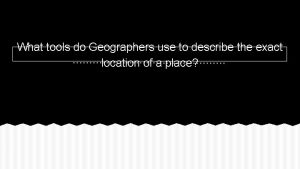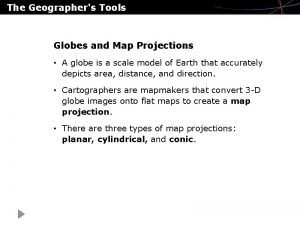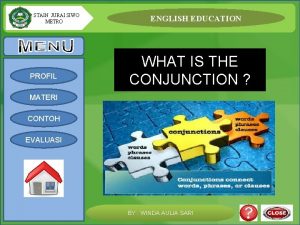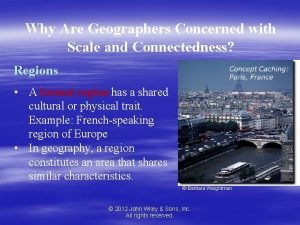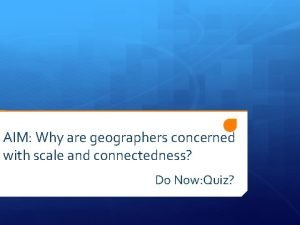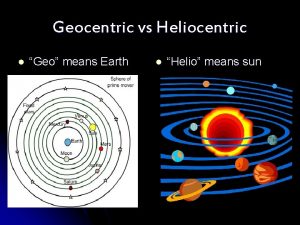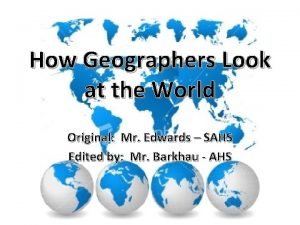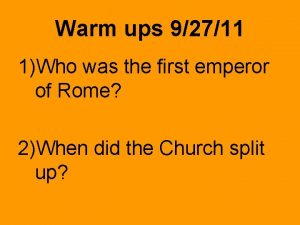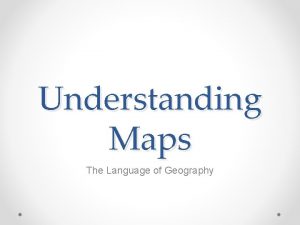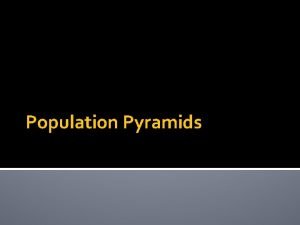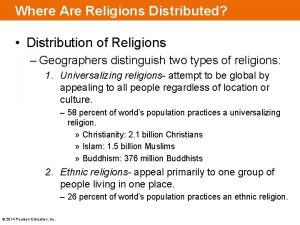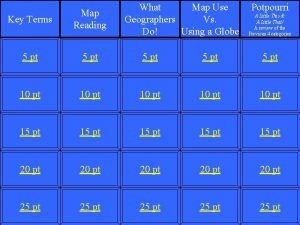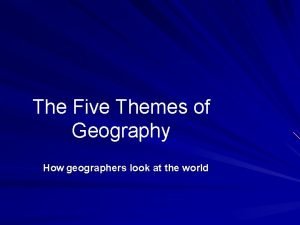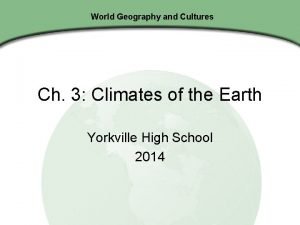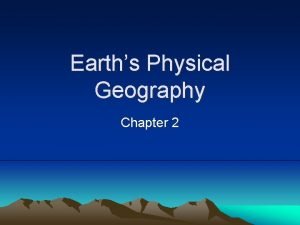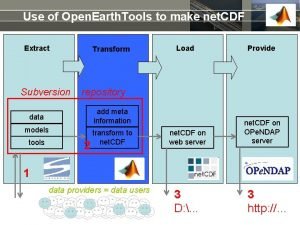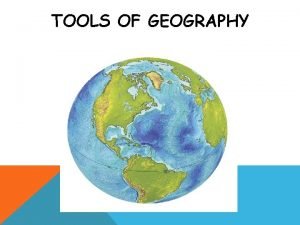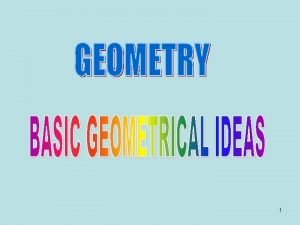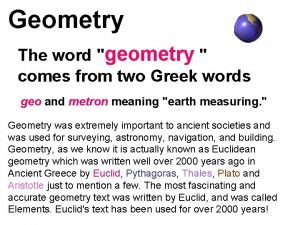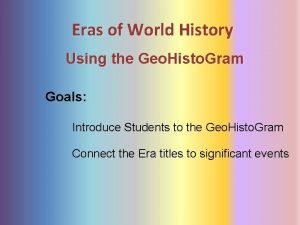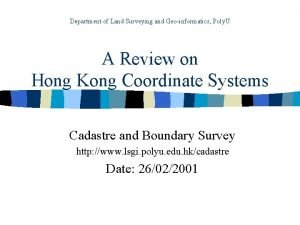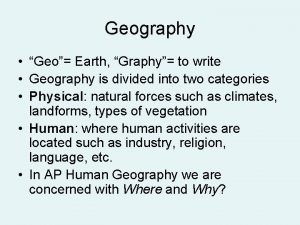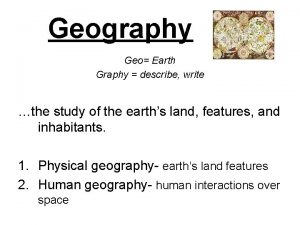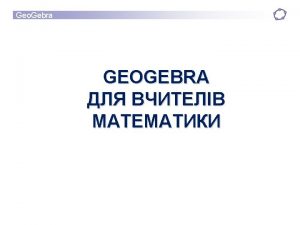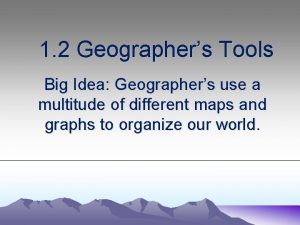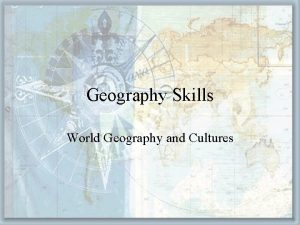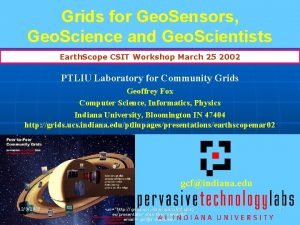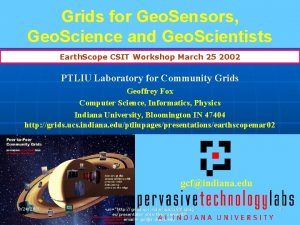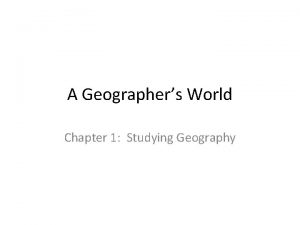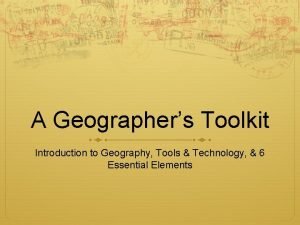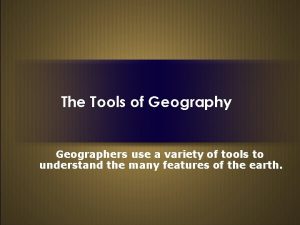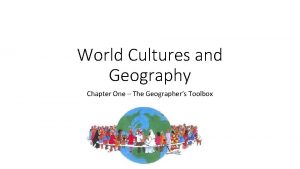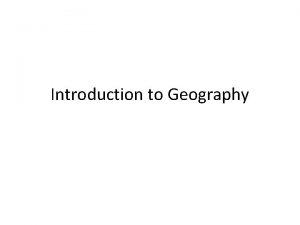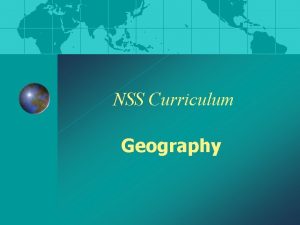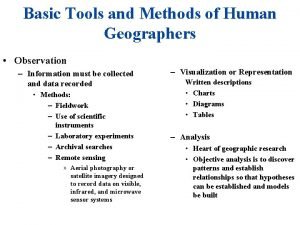Geographers Tools Geography geo Earth and graphy to


























- Slides: 26


Geographers Tools • Geography “geo” Earth and “graphy” to write – From the Greek ‘geographia’ • Maps – a 2 -dimensional (flat) model of the 3 dimensional Earth – reference – communication • Cartography – the science of map making • Spatial Organization – the location and patterns of people, places, and events that connect us to our landscapes (physical and human)

Ancient Guys to Know • Eratosthenes (276? – 194? BCE) – Calculated the circumference of the Earth within 15% – Combination of geography and geometry! • Ptolemy – Calculated the circumference of the Earth as 9, 000 miles smaller and regarded as truth – Developed a grid system that became a forerunner for latitude and longitude

Eratosthenes’ Map


What does this map tell us?

2 -D Distorts • Globe is accurate, but limited • Projections (Map) – the scientific method of transferring locations on Earth’s surface to a flat map – Shape – Distance – Size – Direction

Mercator

Mercator

Mercator Projection • Gerardus Mercator (1512 – 1594); Flemish cartographer, philosopher, and mathematician – Created the Mercator Projection in 1569 – 1569: Historical Context: Age of Exploration – Fast Fact: first used the word atlas to describe a collection of maps

Loxodromes/Rhumb Lines – straight lines of constant compass bearing; produced by Mercator’s projection - Meridians and parallels cross at 90 degrees - Excellent for navigation - Beloved by explorers

So What’s the Problem with Mercator? • DIRECTION is true (thanks loxodromes!) • SIZE is distorted (especially at the poles) – Greenland Antarctica

Robinson Projection

Robinson Projection • Arthur H. Robinson (1915 – 2004); American geographer and cartographer – Created in 1961 - 63 in response to Rand Mc. Nally - Adopted by National Geographic in 1988, later abandoned in favor of Van der Grinten - Specifically intended to solve the problems of other flat projections (neither equal area, or preserving land mass, nor conformal, or preserving angles)

So What’s the Problem with Robinson? • EVERYTHING is a little bit distorted – Shape – Size – Distance – Direction • Helpful for general reference; often used in classrooms

Peters Projection

Peters Projection • Dr. Arno Peters (1916 – 2002); German historian and cartographer – Introduced his version in Germany at a conference in 1974 - English version published in 1983 - Generated firestorm of debate immediately - Eurocentric ideas vs. misleading maps for 500+ years (interested in political propaganda) - Based on Rev. James Gall’s projection, one of the first equal area maps – now commonly the Gall-Peters projection

So What’s the Problem with Peters? • SIZE is true (land masses are equal and not Eurocentric) • SHAPE is distorted (looks unfamiliar!)

Goode-Homolosine Projection

Goode-Homolosine Projection • John Paul Goode (1862 – 1932) ; American geographer and cartographer – Introduced in 1923 as the “Evil Mercator” - Attempt to offer an alternative to Mercator when representing global relationships - Equated map projections to an orange peel - Interruptions and lobes - In its most common form, the map interrupts the North Atlantic, the South Pacific, the Indian Ocean, and the entire east/west meridian of the map.

So What’s the Problem with Goode. Homolosine? • INTERRUPTED – points on the map are not continuous and therefore distorts distance; however, continents and regions are mostly intact rather than separated (sometimes regions are repeated in order to avoid interruption) • SIZE– preserved to insure accurate representation of the continents


Cartography is Concurrent Waterman Butterfly (1996) - Steve Waterman (d. 2015) - Modeled after Bernard J. S. Cahill’s (1866 – 1944) rubber ball/butterfly map - Life long pursuit to eliminate distortion in 2 Dimensional maps - All continents are uninterrupted


Map Projection Humor What does your favorite map projection say about you? https: //xkcd. com/977/ Waterman Butterfly (1996) http: //www. watermanpolyhedron. com/worldm ap. html

NEXT WEEK: REGIONALIZATION
 Geographers tools
Geographers tools Geographers tools
Geographers tools Root word for graph
Root word for graph Staino graphy
Staino graphy Sin graphy
Sin graphy Scale of inquiry
Scale of inquiry Why are geographers concerned with scale and connectedness?
Why are geographers concerned with scale and connectedness? Geocentric vs heliocentric
Geocentric vs heliocentric Krono original
Krono original What was the nomadic lifestyle
What was the nomadic lifestyle A primary reason that geographers study maps is to
A primary reason that geographers study maps is to Why do geographers use population pyramids
Why do geographers use population pyramids 3 major branches of christianity
3 major branches of christianity What basic questions guide geographers
What basic questions guide geographers How geographers look at the world worksheet answers
How geographers look at the world worksheet answers World geography chapter 3 climates of the earth answers
World geography chapter 3 climates of the earth answers Earth's physical geography chapter 2
Earth's physical geography chapter 2 Open earth tools
Open earth tools Ap human geography frq examples
Ap human geography frq examples 5 themes of geography ap human geography
5 themes of geography ap human geography Proruption ap human geography
Proruption ap human geography Special purpose maps
Special purpose maps Sewing tools measuring tools
Sewing tools measuring tools Geo and metron
Geo and metron Greek words with meaning
Greek words with meaning Histo and geo note
Histo and geo note Hong kong 1980 grid system
Hong kong 1980 grid system
